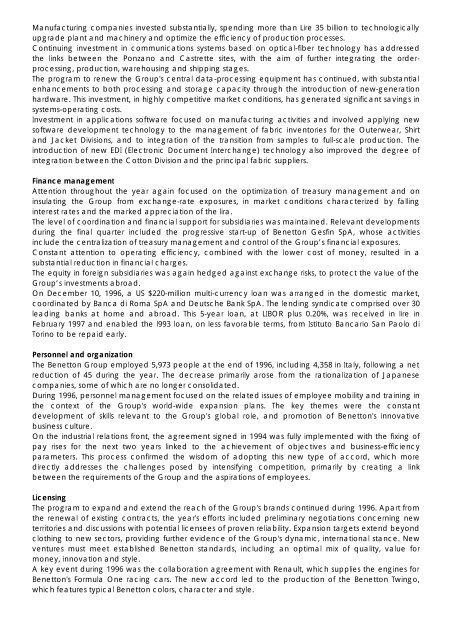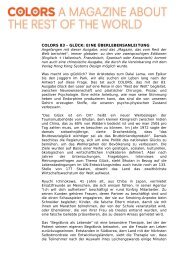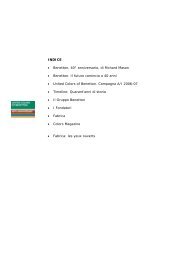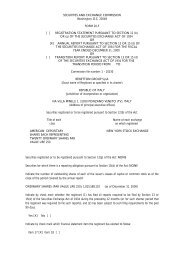The Benetton Group Annual Report 1996
The Benetton Group Annual Report 1996
The Benetton Group Annual Report 1996
Create successful ePaper yourself
Turn your PDF publications into a flip-book with our unique Google optimized e-Paper software.
Manufacturing companies invested substantially, spending more than Lire 35 billion to technologically<br />
upgrade plant and machinery and optimize the efficiency of production processes.<br />
Continuing investment in communications systems based on optical-fiber technology has addressed<br />
the links between the Ponzano and Castrette sites, with the aim of further integrating the orderprocessing,<br />
production, warehousing and shipping stages.<br />
<strong>The</strong> program to renew the <strong>Group</strong>'s central data-processing equipment has continued, with substantial<br />
enhancements to both processing and storage capacity through the introduction of new-generation<br />
hardware. This investment, in highly competitive market conditions, has generated significant savings in<br />
systems-operating costs.<br />
Investment in applications software focused on manufacturing activities and involved applying new<br />
software development technology to the management of fabric inventories for the Outerwear, Shirt<br />
and Jacket Divisions, and to integration of the transition from samples to full-scale production. <strong>The</strong><br />
introduction of new EDI (Electronic Document Interchange) technology also improved the degree of<br />
integration between the Cotton Division and the principal fabric suppliers.<br />
Finance management<br />
Attention throughout the year again focused on the optimization of treasury management and on<br />
insulating the <strong>Group</strong> from exchange-rate exposures, in market conditions characterized by falling<br />
interest rates and the marked appreciation of the lira.<br />
<strong>The</strong> level of coordination and financial support for subsidiaries was maintained. Relevant developments<br />
during the final quarter included the progressive start-up of <strong>Benetton</strong> Gesfin SpA, whose activities<br />
include the centralization of treasury management and control of the <strong>Group</strong>’s financial exposures.<br />
Constant attention to operating efficiency, combined with the lower cost of money, resulted in a<br />
substantial reduction in financial charges.<br />
<strong>The</strong> equity in foreign subsidiaries was again hedged against exchange risks, to protect the value of the<br />
<strong>Group</strong>’s investments abroad.<br />
On December 10, <strong>1996</strong>, a US $220-million multi-currency loan was arranged in the domestic market,<br />
coordinated by Banca di Roma SpA and Deutsche Bank SpA. <strong>The</strong> lending syndicate comprised over 30<br />
leading banks at home and abroad. This 5-year loan, at LIBOR plus 0.20%, was received in lire in<br />
February 1997 and enabled the l993 loan, on less favorable terms, from Istituto Bancario San Paolo di<br />
Torino to be repaid early.<br />
Personnel and organization<br />
<strong>The</strong> <strong>Benetton</strong> <strong>Group</strong> employed 5,973 people at the end of <strong>1996</strong>, including 4,358 in Italy, following a net<br />
reduction of 45 during the year. <strong>The</strong> decrease primarily arose from the rationalization of Japanese<br />
companies, some of which are no longer consolidated.<br />
During <strong>1996</strong>, personnel management focused on the related issues of employee mobility and training in<br />
the context of the <strong>Group</strong>'s world-wide expansion plans. <strong>The</strong> key themes were the constant<br />
development of skills relevant to the <strong>Group</strong>'s global role, and promotion of <strong>Benetton</strong>'s innovative<br />
business culture.<br />
On the industrial relations front, the agreement signed in 1994 was fully implemented with the fixing of<br />
pay rises for the next two years linked to the achievement of objectives and business-efficiency<br />
parameters. This process confirmed the wisdom of adopting this new type of accord, which more<br />
directly addresses the challenges posed by intensifying competition, primarily by creating a link<br />
between the requirements of the <strong>Group</strong> and the aspirations of employees.<br />
Licensing<br />
<strong>The</strong> program to expand and extend the reach of the <strong>Group</strong>'s brands continued during <strong>1996</strong>. Apart from<br />
the renewal of existing contracts, the year's efforts included preliminary negotiations concerning new<br />
territories and discussions with potential licensees of proven reliability. Expansion targets extend beyond<br />
clothing to new sectors, providing further evidence of the <strong>Group</strong>'s dynamic, international stance. New<br />
ventures must meet established <strong>Benetton</strong> standards, including an optimal mix of quality, value for<br />
money, innovation and style.<br />
A key event during <strong>1996</strong> was the collaboration agreement with Renault, which supplies the engines for<br />
<strong>Benetton</strong>'s Formula One racing cars. <strong>The</strong> new accord led to the production of the <strong>Benetton</strong> Twingo,<br />
which features typical <strong>Benetton</strong> colors, character and style.
















